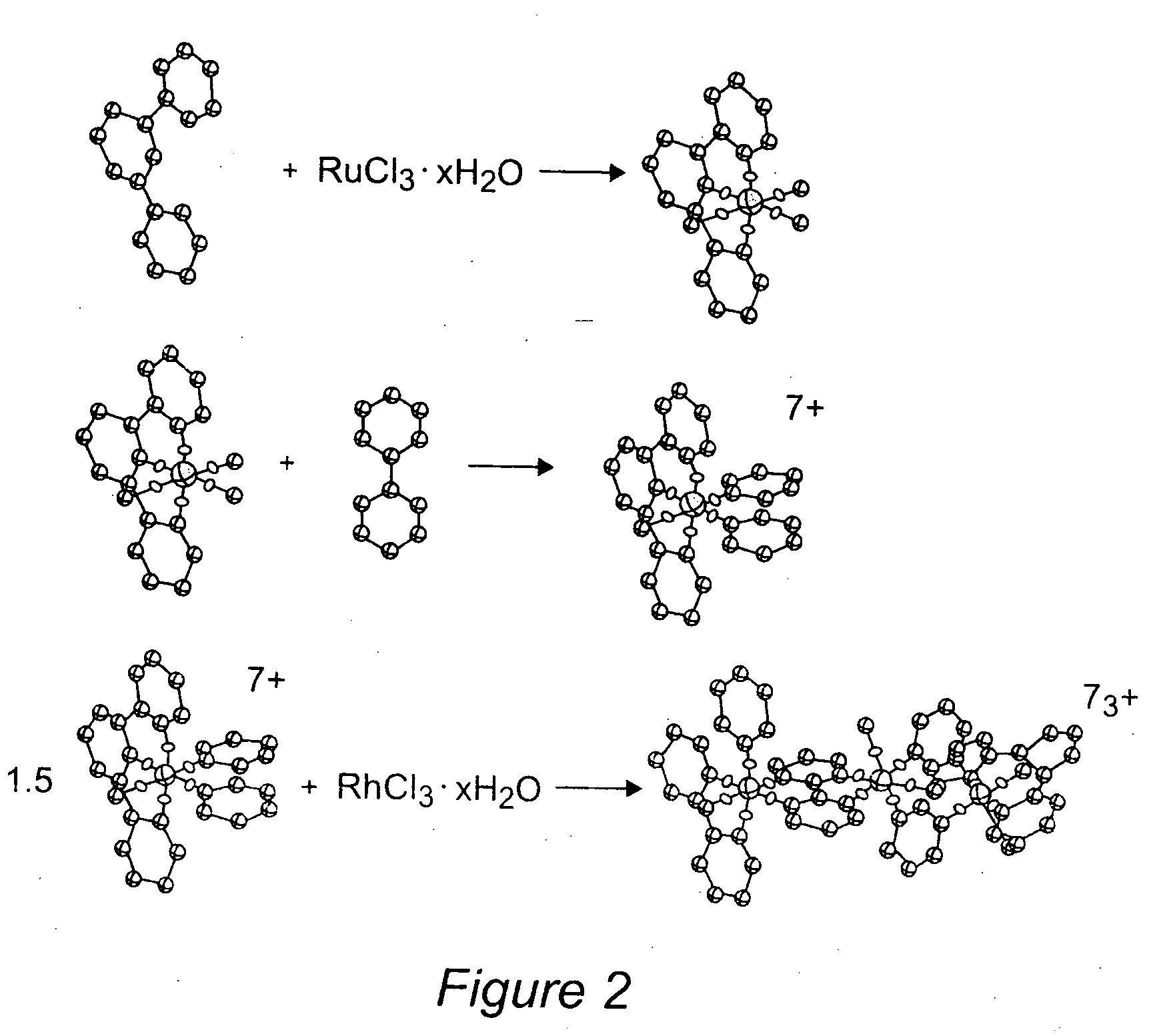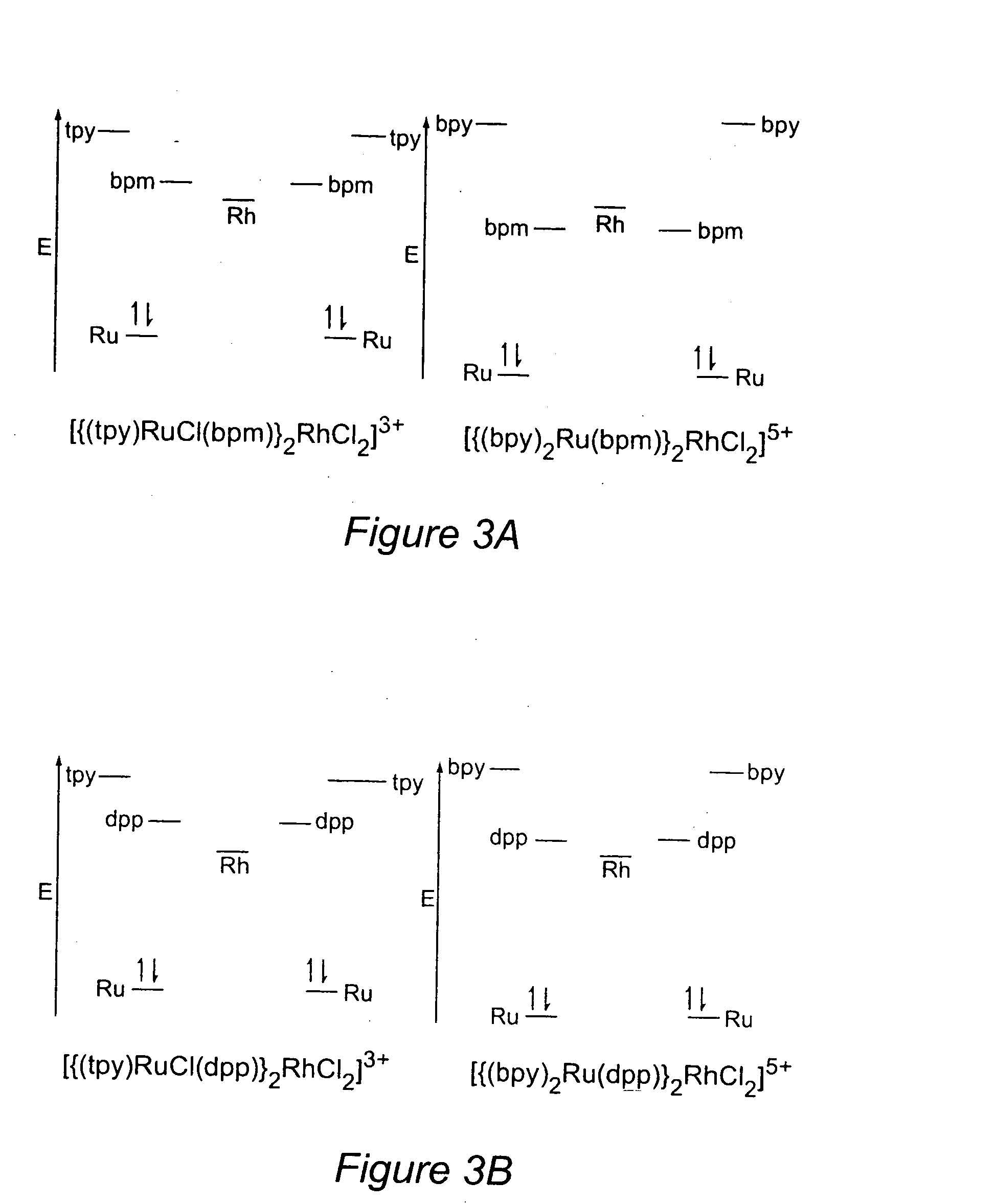Supramolecular complexes as photoactivated DNA cleavage agents
a supermolecular complex and photoactivated technology, applied in the direction of ruthenium organic compounds, biocide, group 5/15 element organic compounds, etc., to achieve the effect of decreasing the replication of hyperproliferating cells
- Summary
- Abstract
- Description
- Claims
- Application Information
AI Technical Summary
Benefits of technology
Problems solved by technology
Method used
Image
Examples
example 1
Synthesis
[0076] The supramolecular complexes [{(tpy)RuCl(dpp)}2RhCl2](PF6)3 and [{(tpy)RuCl(bpm)}2RhCl2](PF6)3 were prepared in good yields under mild conditions using a building-block approach. It is this method that allows for easy variation of structural components within this structural motif. The tpy is first bound to ruthenium followed by BL attachment.45,46 The trimetallic complexes are assembled by reaction of the [(tpy)RuCl(BL)](PF6), where BL=dpp or bpm, with a slight excess of rhodium(III) trichloride hydrate. The synthesis of [{(tpy)RuCl(bpm)}2RhCl2](PF6)3 by this method is illustrated in FIG. 2. This method of binding the bpm or dpp ligand to the ruthenium metal center first and then binding to the rhodium metal center yields clean reactions with easily purified products. The use of excess rhodium(III) trichloride hydrate ensures that most of the monometallic precursor is reacted. The major product in each case is the desired trimetallic. The excess rhodium(III) trichl...
example 2
[0080] Trimetallic complexes of the form [{(bpy)2Ru(CL)}2RhCl2]5+ are characterized by reversible ruthenium oxidations, irreversible rhodium reductions, and reversible ligand reductions, with the BLs (dpp or bpm) being reduced prior to the bpy ligands.32,34 They display a Ru(dσ) HOMO. The LUMO is localized on Rh(dσ*) for dpp and bpm(π*) for the bpm bridged system.
[0081] The cyclic voltammogram of [{(tpy)RuCl(dpp)}2RhCl2]3+ in 0.4 M Bu4NPF6 / CH3CN solution is illustrated in FIG. 4A and summarized in Table 1.
TABLE 1Electrochemical Properties for a Series of Ru(II) and Ru(II) / Rh(III) / Ru(II)Trimetallic Complexes Where tpy = 2,2′:6′,2″-Terpyridine,dpp = 2,Bis(2-pyridyl)pyrazine, and bpm = 2,2′-BipyrimidineE1 / 2 in Va (ΔEp in mV)assignment[{(tpy)RuCl(dpp)}2RhCl2](PF6)3 1.12 (85) 2RuIII / IIEpc = 0.47III / I−0.87 (140)dpp, dpp / dpp, dpp−−1.20 (95) dpp, dpp− / dpp−, dpp−[{(tpy)RuCl(bpm)}2RhCl2](PF6)3 1.12 (100)2RuIII / IIEpc = −0.26RhIII / IEpc = −0.38RhII / I−0.70 (100)bpm, bpm / bpm,...
example 3
Electronic Absorption Spectroscopy
[0087] The electronic absorption spectral data in acetonitrile of the new trimetallic complexes, [{(tpy)RuCl(dpp)}2RhCl2]3+ and [{(tpy)RuCl(bpm)}2RhCl2]3+, as well as their monometallic precursors and trimetallic bpy analogues are assembled in Table 2. The UV regions of the spectra for all of these complexes show BL (dpp or bpm) and terminal ligand (tpy or bpy) π to π* transitions with the BLs expected to show the lowest lying π to π* bands.1,4-9,34,47,51 The visible regions of the spectra are dominated by overlapping Ru(dπ) to BL(π*) and Ru(dπ) to bpy or tpy(π*) charge transfer (CT) transitions with BL based bands occurring at lower energy.
TABLE 2Electronic Absorption Spectroscopy for a Series of Ru(II) andRu(II) / Rh(III) / Ru(II) Trimetallic Complexes Where tpy = 2,2′:6′,2″-Terpyridine, dpp = 2,3-Bis(2-pyridyl)pyrazine, and bpm = 2,2′-Bipyrimidineaλmax (nm)∈× 10−4 (M−1 cm−1)assignments[{(tpy)RuCl(dpp)}2RhCl2](PF6)32744.7tpy (π→π*)3146.48tpy (π→π*)...
PUM
| Property | Measurement | Unit |
|---|---|---|
| ionic strength | aaaaa | aaaaa |
| weight | aaaaa | aaaaa |
| diameter | aaaaa | aaaaa |
Abstract
Description
Claims
Application Information
 Login to View More
Login to View More - R&D
- Intellectual Property
- Life Sciences
- Materials
- Tech Scout
- Unparalleled Data Quality
- Higher Quality Content
- 60% Fewer Hallucinations
Browse by: Latest US Patents, China's latest patents, Technical Efficacy Thesaurus, Application Domain, Technology Topic, Popular Technical Reports.
© 2025 PatSnap. All rights reserved.Legal|Privacy policy|Modern Slavery Act Transparency Statement|Sitemap|About US| Contact US: help@patsnap.com



